
Ski Touring the Silvretta Alps - Eyewear review
We arrived on the Saturday evening at our hotel in Galtur which gave us the Sunday to spend in the nearby ski resort of Wirl (pronounced Varl) getting our ski legs back and practicing a little off piste skiing. Both Phillippa and I had only received our sunglasses from Julbo a few days before our trip so we had no time to try them out until we arrived at the resort.
 Wirl is a small hidden ski resort a short bus ride from Galtur. The ski slopes were remarkably quite, used predominantly by locals. I can only assume that most tourists were based further down the road at Ischgl ski resort which is much larger. As there had been over a metre of snow that had fallen the week before, the slopes were great both on and off piste and no queue's at the lifts and the quite slopes were a bonus.
Wirl is a small hidden ski resort a short bus ride from Galtur. The ski slopes were remarkably quite, used predominantly by locals. I can only assume that most tourists were based further down the road at Ischgl ski resort which is much larger. As there had been over a metre of snow that had fallen the week before, the slopes were great both on and off piste and no queue's at the lifts and the quite slopes were a bonus.
I arrived at the the top of the first ski lift and wore my Julbo Venturi prescription varifocal sunglasses for the first time and soon began to realise this might have been a mistake. The Venturi sunglasses has large lenses that curve around the eyes. They are designed to provide exceptional periphery vision but can provide a weird sensation if, as in my case, you have never worn these type of lenses before. It is similar to placing a goldfish bowl over your head and looking through it! Well, not quite like that, but it was a little disconcerting when I was about to descend down my first red slope of the season. I have often advised customers to wear their frames as much as possible for about two weeks to allow their brain to adjust to the lens curvature. It is like riding a bike for the first time, once you have learned to balance on it, you will always be able to ride one. The same goes for highly curved high performance lenses. Once your brain has adjusted, your vision resorts back to normal with the benefit of having exceptional all round vision. Fortunately, whether it was my survival instincts kicking in or being able to accommodate quickly, my eyes seemed to have fully adapted by the time I reached the bottom of the slope.
Phillippa had ordered a pair of Julbo Breeze sunglasses. Being more sensible, she had worn them during breakfast and had already accommodated to dynamics of the lenses. You might be wondering whether she looked a little like Ray Charles wearing sunnies at breakfast but that was not the case. We had both selected the Zebra Light lenses which are a category 1 to 3 photochromic lens with a light transmission from 75% to 17%. This meant that the lenses were clear to anyone looking at her while in the hotel. Though these prescription lenses are not ideal for high altitude ski touring it did mean that we could take only one pair of prescription sunglasses with us that could also be used in the huts at night minimising on carrying any additional weight/volume. Spare glasses are also not as robust as our sunglasses that have lenses made from a bullet proof material called NXT. Glasses would have also been much more susceptible to breakage in a rucksack full of clunky avalanche and glacial rescue gear.
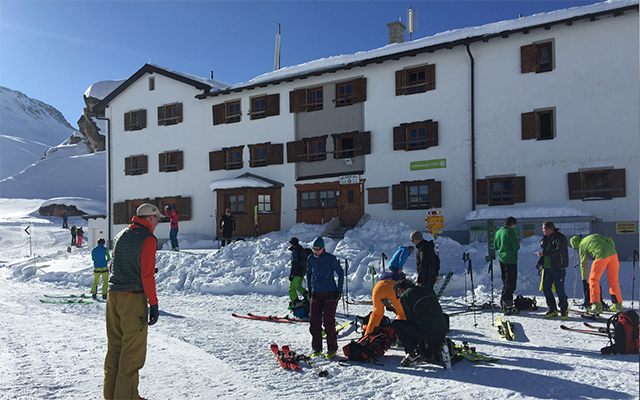 We started our ski touring adventure in Ischgl on Monday taking the cable car to the summit of Piz das Val Gronda at 2812m. Both Phillippa and I had never been ski touring before so we were both excited and apprehensive. We were in the capable hands of Mark, our Mountaineering Guide who is based at Glenmoore Lodge in Scotland. On this trip we were joined by three others from the UK who reassuringly had similar skill sets to us. Having practiced skiing on and off piste with a 12kg pack on our backs and avalanche rescue with our transceivers, shovels and probes, we set off for the Heidleberger hut at 2305m. On this route there were no glaciers to be concerned with and little avalanche threat so we managed to spend some time practicing our kick turns and skinning down hills prior to arriving at the Hut.
We started our ski touring adventure in Ischgl on Monday taking the cable car to the summit of Piz das Val Gronda at 2812m. Both Phillippa and I had never been ski touring before so we were both excited and apprehensive. We were in the capable hands of Mark, our Mountaineering Guide who is based at Glenmoore Lodge in Scotland. On this trip we were joined by three others from the UK who reassuringly had similar skill sets to us. Having practiced skiing on and off piste with a 12kg pack on our backs and avalanche rescue with our transceivers, shovels and probes, we set off for the Heidleberger hut at 2305m. On this route there were no glaciers to be concerned with and little avalanche threat so we managed to spend some time practicing our kick turns and skinning down hills prior to arriving at the Hut.
If you are used to mountain huts that comprise layers of benches with areas for sleeping 10 to a row and three rows high, then you will be pleasantly surprised by the Huts on the Silvretta ski tour. They are more like hotel sized youth hostels that have been designed to provide rooms of various sizes with bunk or single beds. The catering was also surprisingly to a high standard providing three course meals of the day. They even catered for vegetarians.
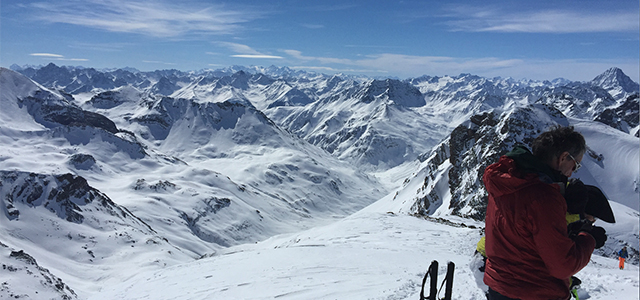 On Tuesday we headed for the Jamtal Hut via the Kronejoch peak at 2958m. We had to discard our ski's and climb on foot to the peak. Even though it was not the highest peak in the Alps, once at the top, the views were breathtaking. With the clear sky's and little if any cloud, we could see a huge area of the Alps, literally hundreds of peaks. I felt like I was on the top of the world.
On Tuesday we headed for the Jamtal Hut via the Kronejoch peak at 2958m. We had to discard our ski's and climb on foot to the peak. Even though it was not the highest peak in the Alps, once at the top, the views were breathtaking. With the clear sky's and little if any cloud, we could see a huge area of the Alps, literally hundreds of peaks. I felt like I was on the top of the world.
By the time we had descended to the Hut, we had adjusted to skiing off piste with the heavy packs on our backs and could enjoy the large wide runs down from the peak. Most of us were equipped with Black Crow ski's that are designed for ski touring. They were extremely light compare to normal ski's and also performed well on piste.
We left the Jamal Hut on Wednesday and headed for the Wiesbaden Hut via the Ober Ochsencharte peak at 2977m. I found the ascent tiring which probably reflected my general age and fitness. I began to realise that you need to pace yourself while skinning up to the col so that you still have the energy to ski back down again. Once I reached the top I had little energy left to perform jump turns and had to settle for wider traverses.
We stayed two nights at the Wiesbaden Hut and Mark, our guide, gleefully explained that we would not need to take a full pack on our backs for the circular trip the next day. I went to my bunk re-assured and dreamed of skinning lightweight up to the Piz Buin range the next day. On awakening I realised that other than the survival gear (shovel, probe, ice axe, crampons, ski crampons, 30m rope, harness, several carabiners, prussic knots, and ice screw) the only spare items I could take out of my pack was my tooth brush, small traveling toothpaste and my pyjarmers that doubled for my evening wear. I was gutted!
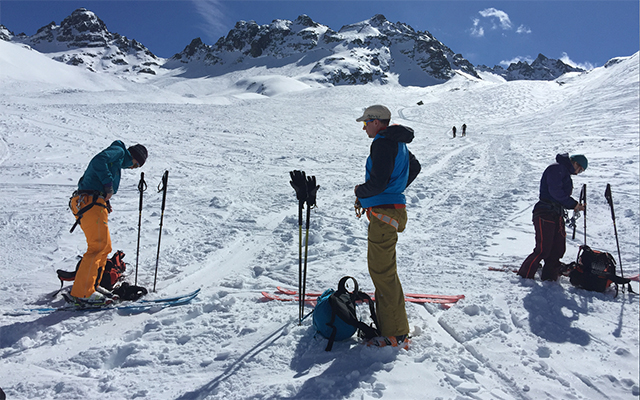 On Friday we left the Wiesbaden Hut and skinned the Rauhkopf glacier to the col next to the Rauher range. We then had an amazing descent to the Silvrettedorf hotel. This was the longest descent of the tour into a hidden valley. We had a combination of silky off piste skiing with areas covered by avalanche debris that needed manoeuvring. After a light lunch at the Hotel we then descended by the Silvretta Hochslpenstrabe down to Wirl and a short bus ride back to our Hotel.
On Friday we left the Wiesbaden Hut and skinned the Rauhkopf glacier to the col next to the Rauher range. We then had an amazing descent to the Silvrettedorf hotel. This was the longest descent of the tour into a hidden valley. We had a combination of silky off piste skiing with areas covered by avalanche debris that needed manoeuvring. After a light lunch at the Hotel we then descended by the Silvretta Hochslpenstrabe down to Wirl and a short bus ride back to our Hotel.
We were extremely lucky with the weather. Only the week before on Thursday the entire Silvretta area was shut down due to Extreme avalanche risk. On the previous Wednesday there was a series of avalanches that took place in the Jamtalferner glacier which we travelled through the following week. During the avalanche a person was buried under a meter and half of snow and fortunately was found within 10 minutes. During our tour we had wall to wall sunshine and the avalanche risk had dropped to level 2. This made it an ideal opportunity to test our sunglasses but not the Julbo goggles we had brought with us.
Tip: White coloured sunglasses reflect heat better which will help to keep your face cooler while Black sunglasses absorb the suns rays. So if you are expecting the weather to be mostly sunny, consider buying lighter coloured sunglasses.
If you have clicked on the links, you will note that the prescription sunglasses we selected are clearly not your typical sunglasses for mountaineering or ski touring. If I had a limitless pocket for prescription eyewear, I would have selected the Julbo Explorer sunglasses with removable side protectors, headband and adjustable temple arms. However, I took the view that if I am buying a pair of state of the art sports sunglasses, I also want to use them during the rest of the year for my triathlons - running and cycling. The Venturi seemed to fit both the winter and summer requirements for me. They have 8 base, highly curved lenses that fit all around the face to prevent sunlight and wind penetrating from the side and the lenses are also large enough to curve down and prevent light from seeping in from below. Phillippa took the same view with the Julbo Breeze. This was the theory but how did they perform in practice?
It is generally accepted that you should be wearing category 4 lenses that go down to around 5% light transmission when mountaineering, trekking or ski touring at high altitudes and we were keen to test whether this was really necessary for a weeks ski touring in the Alps. The downside of buying category 4 lenses is that you can only use them in this environment. If you are keen on using your prescription frames for other sports such as cycling in lower climes they are unnecessary and too dark (unless your are sensitive to light). They are also illegal for use in cars as you are unable to determine colour differences such as whether the traffic lights are red or green! Not a problem skiing across a glacier but a big concern driving in a city.
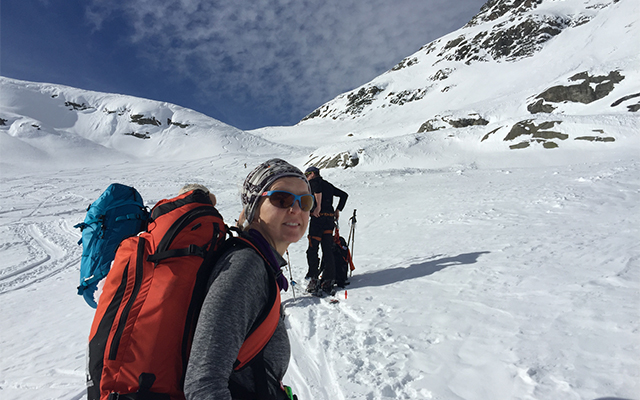 We were fortunate that we had sunshine all week and would you believe, almost no wind. This gave us a good opportunity to test whether the photochromic lenses that transitioned down to 17% light absorption was sufficiently dark enough. The only time I noticed a major problem was when we were on a chair lift on the first day and the sun was directly in front of us and reflecting on the snow below. I did squint my eyes. However, during the five days ski touring across the Silvretta Alps I didn't really notice any issues. Whether this was because I was too busy concentrating on trying to keep up with everyone else skinning up to the col or that my eyes adapted to the light, I do not know.
We were fortunate that we had sunshine all week and would you believe, almost no wind. This gave us a good opportunity to test whether the photochromic lenses that transitioned down to 17% light absorption was sufficiently dark enough. The only time I noticed a major problem was when we were on a chair lift on the first day and the sun was directly in front of us and reflecting on the snow below. I did squint my eyes. However, during the five days ski touring across the Silvretta Alps I didn't really notice any issues. Whether this was because I was too busy concentrating on trying to keep up with everyone else skinning up to the col or that my eyes adapted to the light, I do not know.
Given that the lenses had full UV A, B and C protection to 400nm, they were just as safe as wearing category 4 prescription sunglasses. So, as long as the sunglasses did not let light through from around the frame, our eyes would have been fully protected. Fortunately, both frames had large wrap around lenses that provided good protection. Neither of us found any light ingress an issue. I have also tried other mountaineering frames such as Julbo's Bivouac and Explorer and found that the light ingress from the top and the bottom of the frames were about the same though the side protection from the Explorer was better.
These frames turned out to be a good compromise. They provide more light than the standard Julbo Zebra category 2 to 4 that start at 35% light transmission and go down to 7%. This was particularly beneficial when skinning in the morning shade in flat light and a major bonus in the hut in an evening when they clear completely.
For me, my sight is my most important sense and I ensure that the optics I am looking through provide the best vision possible. So I am used to wearing the best quality varifocals in my glasses for the office and was concerned when ordering from Julbo their own branded Zebra Light Varifocals that they might not perform which can be an issue with some own branded lenses. Fortunately, the quality of the varifocal lens were outstanding and I have been delighted with them. The lenses provide uninterrupted distance vision with smooth transitions increasing power for intermediate and close up. There was no distortion in the lower periphery area of vision providing sharp vision at all angles without having to move my head. These are without doubt high quality lenses and I am looking forward to using them for cycling as the weather improves.
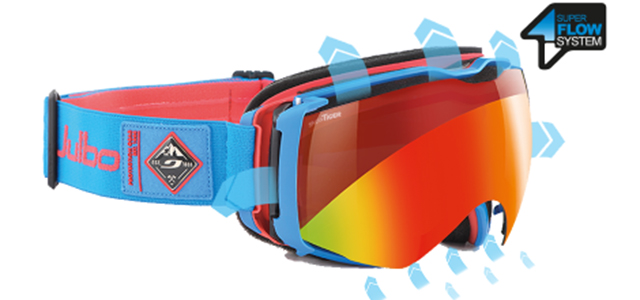 Unfortunately, we were not in a position to test the latest Julbo goggles. Julbo had kindly sent me a pair of Aerospace Chameleon Goggles which are both photochromic and polarising category 2 to 4 with a light transmission from 20% to 5%. I had inserted a standard goggle clip-in to accommodate my prescription. They are ideal for ski touring as they have a feature they call'SuperFlow System' that allows you to adjust forward the chameleon shield enabling air to circulate into the lens without the sun penetrating your vision. During skinning this would certainly help keep the face cool and prevent fogging. Phillippa had a pair of Luna Zebra Light goggles. Both goggle were robust as you would expect from Julbo with double foam layer for comfort and a double lens shield as an additional measure to prevent fogging. Given that there was no wind or snow fall to ne
Unfortunately, we were not in a position to test the latest Julbo goggles. Julbo had kindly sent me a pair of Aerospace Chameleon Goggles which are both photochromic and polarising category 2 to 4 with a light transmission from 20% to 5%. I had inserted a standard goggle clip-in to accommodate my prescription. They are ideal for ski touring as they have a feature they call'SuperFlow System' that allows you to adjust forward the chameleon shield enabling air to circulate into the lens without the sun penetrating your vision. During skinning this would certainly help keep the face cool and prevent fogging. Phillippa had a pair of Luna Zebra Light goggles. Both goggle were robust as you would expect from Julbo with double foam layer for comfort and a double lens shield as an additional measure to prevent fogging. Given that there was no wind or snow fall to ne
- Ordering Prescriptions
- Lens Options Explained
- About Glasses
- About Sunglasses
- About the Eyewear Brands
- Eyecare
- Eye Conditions
- Frequently Asked Questions
- Blog
- About Us
- Why Choose Eyekit for your Prescription?
- Varifocal Prescriptions
- Tint Colour Options for Prescription Lenses
- Special Offers
- Guide to Buying Eyewear Online at Eyekit
- Choosing Eyewear for Sport
Latest From Eyekit
Rain Rain Go Away- Why you need a Crystal Vision Coating on your Prescription Glasses and Sunglasses
The snow was short lived but us Brits know that the Winter/ Spring showers have just begun. You know how it starts, you get out your bike or you figure out your hike for the day on the map and
Eyekit’s Top 10 Tips to Help You Keep Your New Year’s Resolution
Every year we make them and every year we try and try but eventually break them. So its time to stop the cycle and (maybe take up...
Our top 5 Eyewear items to Help Your Eyes this Lock Down
We have looked at our top 5 most popular Eyewear items that people needed during the last lockdown that could help you with this...
Veganuary - Can Excluding Animal Products Have an Impact on Your Eyesight?
We often make connections between diet and cardiovascular disease or obesity but we often forget that eye sight and vision loss is also linked to...
Winter Is Here
Here's how you can help out your eyes this winter. THE SUN HAS GOT HIS HAT ON- even in winter You might only think you need your sunnies...








